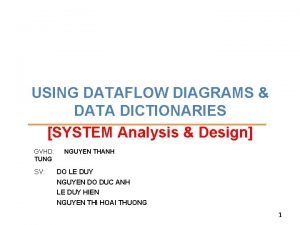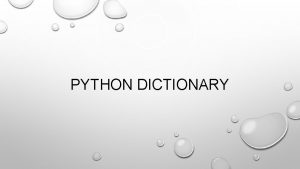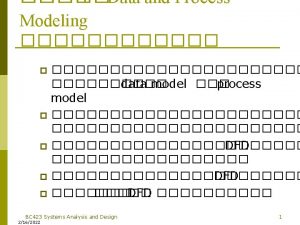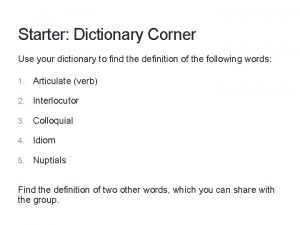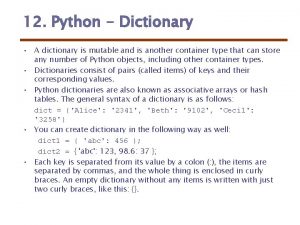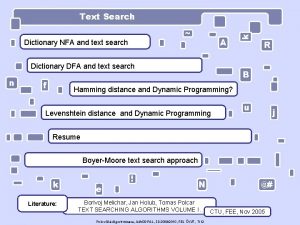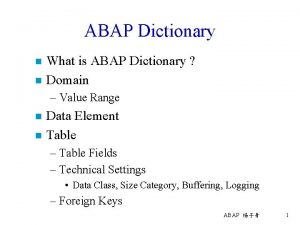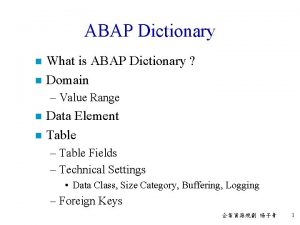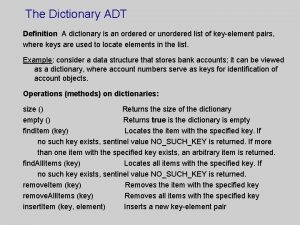DATA DICTIONARY DATA DICTIONARY Introduction The data dictionary












- Slides: 12

DATA DICTIONARY

DATA DICTIONARY - Introduction The data dictionary is a specialised application of the kinds of dictionaries used as reference in everyday life. The data dictionary is a reference work of data about data (that is, metadata), one that is compiled by systems analysts to guide them through analysis and design. As a document, the data dictionary collects and coordinates specific data terms, and it confirms what each term means to different people in the organization.

DATA DICTIONARY - Introduction Data flow diagrams are an excellent starting point for collecting data dictionary entries. Systems analysts must be aware of and catalogue different terms that refers to the same data item. This awareness helps them: avoid duplication of effort, allows better communication between organizational departments sharing a database, and makes maintenance more straightforward. The data dictionary can also serve as a consistent standard of data elements.

AUTOMATED DATA DICTIONARY Automated data dictionaries (also part of CASE tools) are valuable for their capacity to cross-reference data items, thereby allowing necessary program changes to all programs sharing a common element. This feature displaces changing programs on a chaotic basis, or it prevents waiting until the program wont run because a change has been implemented across all programs sharing the same updated item. Clearly, automated data dictionaries become important for large systems that produce several thousand data elements requiring filing (cataloguing) and cross-referencing.

AUTOMATED DATA DICTIONARY

Need to understand DATA DICTIONARIES Many database management systems now come equipped with an automated data dictionary. These dictionaries can either be elaborate or simple. Some computerized data dictionaries automatically catalogue data items when programming is done; others simply provide a template to prompt the person filling in the dictionary to do so in a uniform manner for every entry. Despite the existence of automated data dictionaries, understanding what composes a data dictionary, the convention used in data dictionaries, and how a data dictionary is developed are issues that remain pertinent for the systems analyst during the systems effort.

Need to understand DATA DICTIONARIES Small systems with up to 1000 entries can still be kept effectively in a manual data dictionary. Understanding the process of compiling a data dictionary can aid the system analyst in conceptualizing the system and how it works. Data Dictionary may be used to also: 1. Validate the data flow diagram for completeness and accuracy. 2. Provide a stating point for developing screens and reports. 3. Determine the contents of data stored in files. 4. Develop the logic for data-flow diagram processes.

Describing Data Structures Data structures are usually described using algebraic notation. This method allows the analyst to produce a view of the elements that make up the data structure, along with the information about those elements. For instance, the analyst will denote whethere are many of the same element within the data structure (a repeating group) or whether two elements may exist mutually exclusive of each other. Consider the symbols used in the algebraic notation on the next slide.

Describing Data Structures Symbol Name of Symbol Meaning = Equal sign “is composed of” + Plus Sign “and” { } Curly Braces Indicates repetitive elements, also called repeating groups or tables. There may be one repeating element or several within the group. The repeating group may have conditions, such as a fixed number of repetition or upper and lower limits for the number of repetition. [ ] Square Brackets Represents an either/or situation. Either one element may be present or another, but not both. ( ) Brackets Represents an optional element. Optional elements may be left blank on entry screens and may contain spaces or zeros for numeric fields on file structure.

Creating the DATA DICTIONARY They may be created after data-flow diagram has been completed, or they may be constructed as the data-flow diagram is being developed. The use of algebraic notation and structural records allows the analyst to develop the data dictionary and the data-flow diagram suing the top-down approach.

Creating the DATA DICTIONARY D 2 Employee Timefile D 1 Employee Master Timefile Record Employee Record 5. 3 Employee Paycheck Produce Employee Paycheck Employee Date Flow Diagram Employee Record = Employee Number + Timefile Personal information+ Record = Employee Name + Wage information + Current pay information+ Employee Number + Hours worked Employee Paycheck = Employee Number + Employee Name + Address+ Date Structure Current Pay Amounts

Assignment Do the DATA DICTIONARY for all data flows for your system. Due: Thursday December 13, 2007
